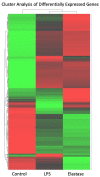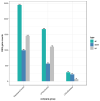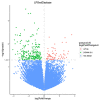Gene Expression of Pregnancy Neutrophils Differs for Protease versus Lipopolysaccharide Stimulation
- PMID: 35563315
- PMCID: PMC9102477
- DOI: 10.3390/ijms23094924
Gene Expression of Pregnancy Neutrophils Differs for Protease versus Lipopolysaccharide Stimulation
Abstract
Neutrophils, which extensively infiltrate maternal systemic blood vessels in preeclampsia, express protease-activated receptor 1 (PAR-1) but only during pregnancy. Neutrophils are generally considered to be non-specific in their response, but the pregnancy-specific expression of PAR-1 could result in a gene expression profile unique to pregnancy, which could help explain why the maternal inflammatory response in preeclampsia is systemic rather than localized. We sought to determine if gene expression of pregnancy neutrophils would differ if stimulated by a protease versus bacterial lipopolysaccharide (LPS). We isolated neutrophils from normal pregnant women at 30 weeks' gestation and cultured them with elastase or LPS. We used elastase because it is a protease elevated in women with preeclampsia, and it activates pregnancy neutrophils via PAR-1. RNA was isolated from the neutrophils for sequencing of the transcriptomes. We discovered many differences in the gene expression profiles. For example, exposure to elastase resulted in three times more uniquely expressed genes than LPS, and the number of significantly differentially upregulated and downregulated genes was greater for elastase. Analysis of canonical pathways revealed similarities for innate immunity but also differences. LPS treatment enriched more pathways, but elastase activated more genes in each pathway. Elastase treatment enriched the MAPK signaling pathway, whereas LPS did not. This is significant because MAPK is a key mediator of transcriptional responses. These findings indicate that protease stimulation of pregnancy neutrophils results in a different profile than stimulation with LPS, which may help explain why the sterile inflammatory response of preeclampsia is systemic and unique to pregnancy.
Keywords: elastase; gene expression; lipopolysaccharide; neutrophils; preeclampsia; pregnancy; protease-activated receptor 1.
Conflict of interest statement
The authors declare no conflict of interest.
Figures




Similar articles
-
Aspirin Inhibits the Inflammatory Response of Protease-Activated Receptor 1 in Pregnancy Neutrophils: Implications for Treating Women with Preeclampsia.Int J Mol Sci. 2022 Oct 30;23(21):13218. doi: 10.3390/ijms232113218. Int J Mol Sci. 2022. PMID: 36362006 Free PMC article.
-
Pregnancy-specific expression of protease-activated receptor 1: a therapeutic target for prevention and treatment of preeclampsia?Am J Obstet Gynecol. 2022 Feb;226(2S):S945-S953. doi: 10.1016/j.ajog.2021.11.1367. Am J Obstet Gynecol. 2022. PMID: 35177224 Free PMC article. Review.
-
Proteases Activate Pregnancy Neutrophils by a Protease-Activated Receptor 1 Pathway: Epigenetic Implications for Preeclampsia.Reprod Sci. 2020 Nov;27(11):2115-2127. doi: 10.1007/s43032-020-00232-4. Epub 2020 Jun 15. Reprod Sci. 2020. PMID: 32542542 Free PMC article.
-
Patterns of Maternal Neutrophil Gene Expression at 30 Weeks of Gestation, but Not DNA Methylation, Distinguish Mild from Severe Preeclampsia.Int J Mol Sci. 2021 Nov 28;22(23):12876. doi: 10.3390/ijms222312876. Int J Mol Sci. 2021. PMID: 34884685 Free PMC article.
-
Matrix Metalloprotease-1 and Elastase Are Novel Uterotonic Agents Acting Through Protease-Activated Receptor 1.Reprod Sci. 2018 Jul;25(7):1058-1066. doi: 10.1177/1933719117732162. Epub 2017 Sep 27. Reprod Sci. 2018. PMID: 28954603 Free PMC article.
Cited by
-
Aspirin Inhibits the Inflammatory Response of Protease-Activated Receptor 1 in Pregnancy Neutrophils: Implications for Treating Women with Preeclampsia.Int J Mol Sci. 2022 Oct 30;23(21):13218. doi: 10.3390/ijms232113218. Int J Mol Sci. 2022. PMID: 36362006 Free PMC article.
-
Exploring the Possibility of RNA in Diverse Biological Processes.Int J Mol Sci. 2023 Jun 26;24(13):10674. doi: 10.3390/ijms241310674. Int J Mol Sci. 2023. PMID: 37445851 Free PMC article.
References
MeSH terms
Substances
Grants and funding
LinkOut - more resources
Full Text Sources

